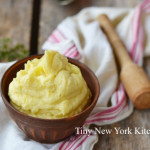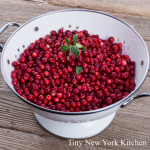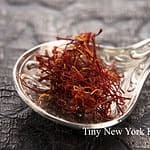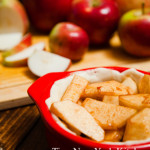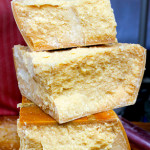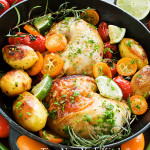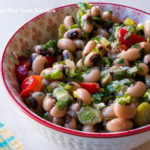Old-School Mashed Potatoes
Mashed potatoes are as American as Thanksgiving itself. Variations range from sriracha to pumpkin spice foie gras mashed potatoes (I wouldn’t recommend that latter). At Thanksgiving, nothing beats a well-made bowl of classic mashed potatoes, however. As with many other deceptively simple dishes, there are reasons why sometimes you have good mashed potatoes, and other times you have fabulous mashed potatoes. Here are my well-kept secrets to make those fabulous ones, served piping hot, and ready for that giant ladle of gravy.
Potatoes with a high starch content (the kind used for baking) provide the traditional flavor and texture. The same starch that gives a baked potato its fluffy interior also contributes to perfect mashed potatoes. Yellow-fleshed varieties like Yukon golds or yellow Finns are excellent as well, but they turn out the same color as mashed turnips, which may be disconcerting to potato purists. If you live near a farmers’ market, take the potato farmers’ advice on local favorites as they may suggest an interesting heirloom variety that will become your favorite.
Purchase your potatoes about a week ahead of time and age them in a cool, dark place. Do not place them in the refrigerator. Mature potatoes are drier and mash up lighter. Please don’t let them sprout eyes, though.
Make mashed potatoes just before serving. Reheated mashed potatoes leave me shivering.
Make sure not to overcook the potatoes. They should just yield to a sharp knife when pierced. If the drained potatoes seem soggy, just return them to the pot and cook over a low heat for about 2 minutes, stirring constantly until they begin to stick to the bottom of the pot. Doing this forces the excess steam out of the potatoes and dries them out.
Mash the drained potatoes in the still warm cooking pot with HOT milk. A cold bowl and cold milk make for lumpy and lukewarm potatoes. The precise amount of milk is a matter of taste, so use more or less to reach your desired consistency.
You’ll need an efficient mashing utensil. Some cooks swear by a potato ricer (which does make the smoothest potatoes by the way), as long as you enlist another pair of hands to make the job go quickly. You may use an electric hand mixer. If you want to use a low-tech, old school hand potato masher, go to a restaurant supply store and get a big one, or the job will take forever. The potatoes will be cooling off by the second and we don’t want that happening. Never ever mash potatoes in a food processor or you’ll get starchy, sticky, gummy mashed potatoes that could be used for gluing kindergarten craft projects.
Season well with salt and pepper. Use your taste to determine amounts. I use kosher salt mostly, but you may use your favorite type of salt. White pepper is spicier than black pepper, but will give you pristine looking mashed potatoes. But, of course, use black if you want to.
www.tinynewyorkkitchen.com
“Work With What You Got!”
© Victoria Hart Glavin Tiny New York Kitchen © 2016 All Rights Reserved
Family & Thanksgiving
More than any other holiday, Thanksgiving has evolved as a time to gather together. On Christmas most Americans stay at home, but on Thanksgiving, many pack up and leave home to spend the holiday with relatives and friends. This is nearly as old a custom of the day as having turkey and pumpkin pie.
The reunion tradition arose in the early eighteenth century as families began dispersing across New England to settle on the frontiers of New England (western Massachusetts, Vermont, New Hampshire, and Maine). Gradually, before and after the Revolutionary War, New Englanders pressed into New York State, Ohio, and even parts of the southern colonies and territories. In the nineteenth century, hundreds of New Englanders went west during the Gold Rush and subsequent westward migrations. And as Boston, New York, and other towns grew into cities, young people left farms to join businesses or to work in industries in urban centers. Thanksgiving was the time people chose for family reunion, to go back to the old homestead for a visit. It still is.
“Work With What You Got!”
© Victoria Hart Glavin Tiny New York Kitchen © 2016 All Rights Reserved
Sweet Potatoes
Sweet Potatoes have a distinctive sugary and spicy flavor, which makes them an excellent addition to many savory dishes. There are two types of this highly nutritious tuber. One has cream-colored flesh and the other has an orange flesh. The orange flesh variety has a higher nutritional content because it is richer in the antioxidant beta-carotene. Both types are a good source of potassium, and contain plenty of nutritional fiber, vitamin C and carbohydrate.
When buying sweet potatoes, choose small or medium-size specimens, as the larger ones tend to be rather fibrous. They should be firm and evenly shaped. Avoid any that seem withered, have damp patches or are sprouting. They will keep for about 8 days if stored in a cool place.
Sweet potatoes can be cooked in any of the ways you would cook ordinary potatoes – roasted, boiled, mashed or baked. They also make delicious fries. If baking, scrub the potatoes well and cook exactly as you would ordinary potatoes. To boil, either cook in their skins and remove them after cooking, or peel and place in acidulated water. This prevents them from turning brown.
“Work With What You Got!”
© Victoria Hart Glavin Tiny New York Kitchen © 2016 All Rights Reserved
Friendsgiving
I’ve had friends, who for years, have been celebrating “Friendsgiving” and look forward to it every year. Friendsgiving is another way to celebrate the season with those who mean the most to you. A friend-focused feast is a great way to include those who don’t have plans on Thanksgiving or to try those new recipes you’ve been checking out. Whether you celebrate on Thanksgiving Day itself or hold a separate dinner altogether, Friendsgiving is a tradition that we, at Tiny New York Kitchen, can get behind.
“Work With What You Got!”
© Victoria Hart Glavin Tiny New York Kitchen © 2016 All Rights Reserved
Cranberries
These tart, bright ruby-red berries grow wild on evergreen shrubs in peaty marshland all over northern Europe and North America. They are closely related to blueberries and bilberries, but are much more sour and are always served cooked. They are closely related to cowberries and lingonberries.
Cranberries are sometimes known as bouceberries since they were traditionally tested for firmness by being bounced seven times. Any berries that failed the bounce test were too squashy and were, therefore, discarded. Because of their waxy skins, cranberries keep for much longer than other berries, which helps to explain their popularity.
Cranberries contain useful amounts of vitamins C and D, potassium and iron. They used to be considered to be good protection against scurvy, and they are known to contain a natural antibiotic. Cranberry juice has long been recommended as a natural remedy for cystitis, kidney, bladder and urinary tract infections.
Look for plump, firm, bright, red berries and check the base of the carton in case of squashed or shriveled berries. Fresh cranberries will keep in the refrigerator for four weeks, or freeze them in plastic bags.
Cranberries can be used in both sweet and savory dishes or can be juiced and served as a drink. Their most famous incarnation is as cranberry sauce. The berries are high in pectin, so they make excellent jams and jellies. They also combine well with orange and apple, and can be mixed with blackberries and raspberries for an autumn version of summer pudding. Cranberry sorbet is a delicious treat. When cooking them for a sweet dish, do not add the sugar until the skins have popped or they will become tough.
“Work With What You Got!”
© Victoria Hart Glavin Tiny New York Kitchen © 2016 All Rights Reserved
Trick-Or-Treat
In the mid-19th century, Irish immigrants to North America brought with them the Gaelic celebrations of All Hallows’ Eve, replete with trick playing and fortune telling. At that time, pranks were mild. Shop signs were switched, gates disassembled, and flour-filled socks were flung at those wearing black coats. Over time the mischief evolved into straight-up vandalism, and people often awoke on November 1st to broken windows or even blazing fires. At the height of the Great Depression, some cities considered banning the holiday. But a few cities, like Chicago, had a much better idea – to busy the idle hands of potential troublemakers with festivities and encourage homeowners to do the same. Because money was scarce, families often held “house-to-house parties,” which kept the children moving door to door for a different entertainment or treat. I guess treats are an excellent bribe for warding off mischief.
www.tinynewyorkkitchen.com
“Work With What You Got!”
© Victoria Hart Glavin Tiny New York Kitchen © 2016 All Rights Reserved
Saffron
Highly prized as a dye, medication and culinary spice since Greek and Roman times, saffron is the stigma of a type of crocus, Crocus sativus, which was once grown all over Europe, including in England. It has a distinctive and lasting aroma, and a pleasant pungency if used sparingly. Because of its striking color, as well as its distinctive flavor, saffron is frequently added to celebration dishes; for example, pilaus from India, Spanish paella and Italian risotto Milanese. Bouillabaisse, the famous French fish and shellfish soup-stew, is flavored with saffron. The spice is also widely used in sweet recipes, including milky rice and sweet custard-like desserts. Baked goods flavored with saffron include breads and cakes.
Saffron threads can be infused (steeped) in a little warm water or milk until the color of the liquid is even. Add the liquid and the threads to the dish, usually towards the end of the cooking process. Saffron powder can be added to food without soaking, but not to hot oil.
“Work With What You Got!”
© Victoria Hart Glavin Tiny New York Kitchen © 2016 All Rights Reserved
The Best Apples For Apple Pie
It’s apple pie season and it’s important to choose the best apples for apple pie. Choosing the right apples for baking can be a daunting task. I mean, seriously, there are over 7,5000 apple varieties. When it comes to pie not all apples are created equal. Choose a mix of firm & tart and firm & sweet varieties. Doing this adds diversity and depth of flavor, while holding their shape during the cooking process. No one wants a mushy pie.
Braeburn: A Firm & Sweet/Tart Variety Originating from New Zealand, Braeburn has a skin that’s muted red with golden-yellow undertones and tinges of faint green. It produces a firm, crisp bite and offers a pleasing balance between sweet and tart. Firm to the touch and great for baking as well as eating raw. Excellent when paired with Honeycrisp. Can be found in most supermarkets.
Granny Smith: A Firm & Tart Variety Classic green apple is firm, slightly sour, and perfect for pie making. It’s available everywhere.
Esopus Spitzenburg: A Firm & Tart Variety This is an heirloom variety that has flavors bright enough to make an excellent snack or pressed into cider. You’ll find this variety at farmers’ markets and makes a delicious pie filling.
Northern Spy: A Firm & Tart Variety Northern spy is thought to be the best apple variety for pies. Difficult to find at supermarkets, but many farmers’ markets have them.
Idared: A Firm & Tart Variety This tart and spicy apple is bright red in color when fully ripe. Not so easy to find in supermarkets, but popular at pick-your-own orchards and farmers’ markets.
Pink Pearl: A Firm & Tart Variety This variety is delicious and you’ll want to seek this variety out. Difficult to find, but can be found at some pick-your-own orchards. Search online in your area for a place to Pink Pearl.
Ginger Gold: A Firm & Sweet Variety Ginger Gold is a baker’s champion. This delicately sweet and crisp variety works well in pies, muffins, and cakes. Can be found in most supermarkets during autumn.
Golden Delicious: A Firm & Sweet Variety This is a mild tasting variety and is best when paired with heftier flavors. Very popular in the U.S. and can be found in any supermarket.
Honeycrisp: A Firm & Sweet Variety This is a crisp and predominately sweet variety. Very popular in the U.S. and can be found in most supermarkets. Great when paired with Braeburn for pie making.
Jazz: A Firm & Sweet Variety Great for eating raw as well as pie making. From New Zealand and can be found in most supermarkets.
Jonagold: A Firm & Sweet Variety A cross between Jonathan and Golden Delicious varieties. Sweet and tart flavor and can be used on its own. Can be found in both supermarkets and farmers’ markets.
Pink Lady: A Firm & Sweet Variety The perfect combination of sweet and sour. Pink Lady is excellent for baking as well as eating raw. Can be found in supermarkets and farmers’ markets.
A Word About McIntosh Apples: Mcintosh variety is a popular choice for many bakers, but I don’t recommend them on their own if you’re using them for pies. They just don’t hold up well to heat and tend to cook down into a sauce before the pie crust is done cooking. If you love the flavor of McIntosh apples and just have to use them in pies then combine them with a much firmer variety like Pink Lady, Jonagold, Honeycrisp, or Northern Spy.
“Work With What You Got!”
© Victoria Hart Glavin Tiny New York Kitchen © 2016 All Rights Reserved
Parmesan Cheese Rinds
I tend to use a lot of good quality Parmesan cheese that I grate myself all the way down to the rind. I used to just toss the rinds until one day a chef friend told me all of the ways to use them. I think of them as the bay leaves of the cheese world. Add them when you’re cooking a dish and make sure to remove them at the end of cooking. Seriously, you’ll discover a while new world of flavor.
Throw into sauces, stews, and soups. Adding a Parmesan rind to sauces, stews, and soups will definitely add a nice rich flavor. Add to Italian dishes (both red and white pasta sauces).
Put them in a jar and pour olive oil over them. This makes Parmesan infused olive oil. You could add garlic cloves as well. This is excellent for dipping bread.
Grill them if your rinds are pure cheese with no waxy coating. They’ll become soft and chewy that is delicious on crusty bread.
Make Parmesan broth for cooking with. It’s so easy. Just add a few rinds with some herbs to a pot of water. Simmer for a couple of hours and after the broth has reduced some strain it and use to cook with.
Use them when you’re cooking vegetables.
Put a rind in the pot when you’re cooking rice or risotto.
The great news is that Parmesan rinds freeze well. You don’t need to use them right away and keep for a few months in the refrigerator. They keep for years in the freezer, however. If you don’t have any rinds on hand you may also purchase them from high-end grocers and cheese shops, where they’re super inexpensive.
www.tinynewyorkkitchen.com
“Work With What You Got!”
© Victoria Hart Glavin Tiny New York Kitchen © 2016 All Rights Reserved

